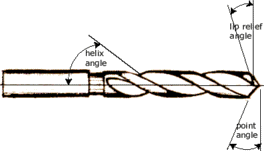 Home & Garden
Home & Garden
 Tools
Tools
 Drill Bits
Contact
Drill Bits
Contact
Don's Home
 Home & Garden
Home & Garden
 Tools
Tools
 Drill Bits
Contact
Drill Bits
Contact
|
| Bolts | Pipes | Drill sizes | Tap sizes |
|
Types:  Twist drill
|
 Spade or Paddle Bit
|
 Auger bit  Expansive bit |
|
'carbon steel', these bits are specially ground for drilling wood and should not be used for drilling metals, they tend to be more brittle, less flexible than HSS bits. High Speed Steel Bits (HSS): Considered to be the industry standard, general purpose drill bit. They perform general purpose drilling with hand and machine tools. Exotic materials these days include black oxide, titanium and cobalt. Cobalt Steel Drill Bits : A more durable, heavy duty high speed steel drill bit that will retain strength and hardness at higher temperatures. Cobalt bits will drill extremely hard materials, including hardened stainless steel, cast iron and titanium. Tin Coated (Titanium) Drill Bits: Super hard titanium nitride surface treatment improves drill life, chip ejection, and productivity; decreases horsepower requirement. Titanium is designed for repetitive heavy-duty drilling in wood, plastic, common stainless steels, carbon and alloy steels, and soft cast iron. Zirconium-coated bits, such as the Craftsman bit sets, are coated with Zirconium nitride for extra strength and feature a split-point and groove design that breaks up chips for faster penetration and more precise drilling. The point design eliminates walking. Masonry bit - The cutting tip is often made from tungsten carbide bonded to a spiralled steel shaft. Some masonry drills are described as 'durium tipped', this term refers to a highly durable silicon bronze alloy used instead of tungsten as the cutting point. Tile Bit A bit for drilling ceramic tiles and glass, it has a ground tungsten carbide tip. They can be used with a hand drill, but are best used in a variable speed power drill on a slow speed. When drilling glass, some form of lubricant (i.e. turpentine or white spirit ) should be used to keep the tip cool.
High cobalt alloy tool steels are best known for having excellent wear and corrosion resistance over a wide variation of temperature ranges. M42 is a high speed steel alloy similar to M35, however it contains roughly 8% cobalt, enabling it to withstand even higher cutting speeds and temperatures, without losing temper. Additionally, wear and chipping are reduced particularly during interrupted cuts. High speed cobalt tools are often identified by the letters HSS-Co, either stamped or electro-etched on the shank of the tool. In recent years, drill manufacturers have adopted a uniform bronze color as an industry standard to identify cobalt tools. This color should not be confused with the bright gold color associated with TIN-coated cutters (see Tin Coated drills). The most common twist drill (the one sold in general hardware stores) has a point angle of 118 degrees. This is a suitable angle for a wide array of tasks, and will not cause the uninitiated operator undue stress by wandering or digging in. A more aggressive (sharper) angle, such as 90 degrees, is suited for very soft plastics and other materials. The bit will generally be self-starting and cut very quickly. A shallower angle, such as 150 degrees, is suited for drilling steels and other tougher materials.
Links: | ||